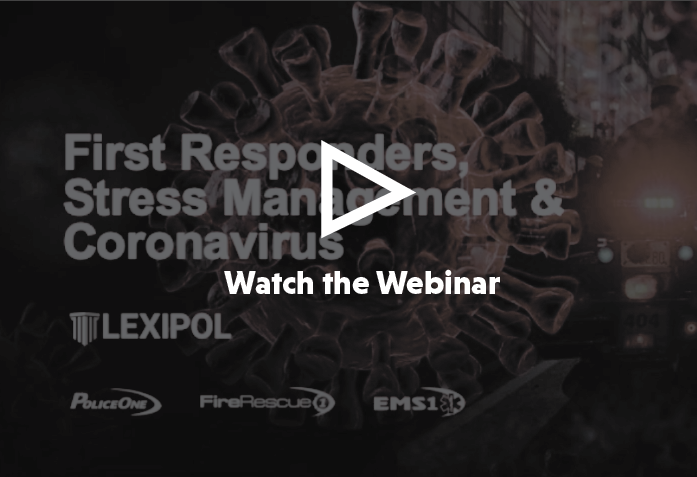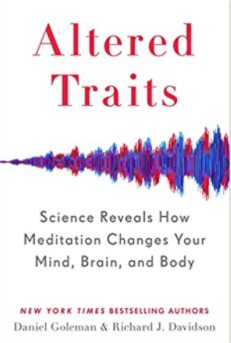A curated selection of programs, videos, books, and scientific articles to deepen your knowledge on stress management and resilience
Programs/Videos Books ResearchPrograms/Videos
Webinar
In March of this year I offered a webinar on stress management for EMS, Police, and Fire professionals with our friends at Lexipol. With 4 a day notice we had 10,600 people sign up. Unfortunately the webinar platform only allowed 3,000 to participate. Tens of thousands have watched it since we posted it. The response and feedback from this inspired us to write the book.
Neuroscience-Based Training Program
The company I work for offers a neuroscience-based training program called ResilientFirst. It’s an app-based system built in collaboration with our Australian partners Hello Driven. It starts with a brief, scientifically-validated, 16-question resilience assessment called the PR6. Then it drops you into a customized training program that takes less than 5 minutes a day to build your resilience.
Books
Research
Bersani, F. S., et al. (2016). Association of dimensional psychological health measures with telomere length in male war veterans. Journal of Affective Disorders, 190, 537–542. https://doi.org/10.1016/j.jad.2015.10.037
Castro, C. A., et al. (2006). Battlemind training: Building soldier resiliency. In Human Dimensions in Military Operations-Military Leaders” Strategies for addressing stress and psychological support (pp. 42-1-42-6). Meeting Proceedings RTO-MP-HFM-134, Paper 42. https://www.researchgate.net/publication/235131172_Battlemind_Training_Building_Soldier_Resiliency
Chen, S. H., Epel, E. S., Mellon, S. H., Lin, J., Reus, V. I., Rosser, R., Kupferman, E., Burke, H., Mahan, L., Blackburn, E. H., & Wolkowitz, O. M. (2014). Adverse childhood experiences and leukocyte telomere maintenance in depressed and healthy adults. Journal of Affective Disorders, 169, 86–90. https://doi.org/10.1016/j.jad.2014.07.035
Conklin, Q. A., et al. (2018). Insight meditation and telomere biology: The effects of intensive retreat and the moderating role of personality. Brain, Behavior, and Immunity, 70, 233–245. https://doi.org/10.1016/j.bbi.2018.03.003
De Baca, T. C., et al. (2017). Sexual intimacy in couples is associated with longer telomere length. Psychoneuroendocrinology, 81, 46–51. https://doi.org/10.1016/j.psyneuen.2017.03.022
Elon Poll— COVID-19 Outbreak. (n.d.). Elon University. Retrieved April 12, 2020, from https://www.elon.edu/u/elon-poll/elon-poll-covid-19-outbreak/
Epel, E. S., et al. (2004). Accelerated telomere shortening in response to life stress. Proceedings of the National Academy of Sciences, 101(49), 17312–17315 https://doi.org/10.1073/pnas.0407162101
Epel, E. S., & Prather, A. A. (2018). Stress, telomeres, and psychopathology: Toward a deeper understanding of a triad of early aging. Annual Review of Clinical Psychology, 14, 371–397. https://doi.org/10.1146/annurev-clinpsy-032816-045054
Goglin, S. E., et al. (2016). Change in leukocyte telomere length predicts mortality in patients with stable coronary heart D=disease from the heart and soul study. PLoS ONE, 11(10). https://doi.org/10.1371/journal.pone.0160748
Kim, P. Y., Kok, B. C., & Thomas, L. J. L. (n.d.). Land combat study of an army infantry division 2003–2009. 22. https://apps.dtic.mil/dtic/tr/fulltext/u2/a563460.pdf
Lai, J., et al. (2020). Factors associated with mental health outcomes among health care workers exposed to coronavirus disease 2020 JAMA Network Open, 3(3), e203976–e203976. https://doi.org/10.1001/jamanetworkopen.2020.3976
MacKinnon, J. B. (2016, August 11). The strange brain of the world’s greatest solo Ccimber. Nautilus. http://nautil.us/issue/39/sport/the-strange-brain-of-the-worlds-greatest-solo-climber
Neria, Y., DiGrande, L., & Adams, B. G. (2011). Posttraumatic stress disorder following the September 11, 2001, terrorist attacks. The American Psychologist, 66(6), 429–446. https://doi.org/10.1037/a0024791
Patterson, P. D., et al. (2012). Association between poor sleep, fatigue, and safety outcomes in Emergency Medical Services providers. Prehospital Emergency Care: Official Journal of the National Association of EMS Physicians and the National Association of State EMS Directors, 16(1), 86–97. https://doi.org/10.3109/10903127.2011.616261
Roediger, H. L. (1990). Implicit memory: Retention without remembering. A Arlington, VA: American Psychologist, 45, 1043. https://www.ncbi.nlm.nih.gov/pubmed/2221571
Harvey, A., Nathens, A. B., Bandiera, G., & LeBlanc, V. R. (2010). Threat and challenge: Cognitive appraisal and stress responses in simulated trauma resuscitations. Medical Education, 44(6), 587–594. https://doi.org/10.1111/j.1365-2923.2010.03634.x
Jamieson, J. P., Nock, M. K., & Mendes, W. B. (2012). Mind over matter: Reappraising arousal improves cardiovascular and cognitive responses to stress. Journal of Experimental Psychology. General, 141(3), 417–422. https://doi.org/10.1037/a0025719
Seery, M. D. (2011). Challenge or threat? Cardiovascular indexes of resilience and vulnerability to potential stress in humans. Neuroscience & Biobehavioral Reviews, 35(7), 1603–1610. https://doi.org/10.1016/j.neubiorev.2011.03.003
Sancar, B., & Aktas, D. (2019). The relationship between levels of Alexithymia and communication skills of nursing students. Pakistan Journal of Medical Sciences, 35(2), 489–494. https://doi.org/10.12669/pjms.35.2.604
Borkovec, T. D., et al. (1983). Stimulus control applications to the treatment of worry. Behavior Research and Therapy, 21(3), 247–251. https://doi.org/10.1016/0005-7967(83)90206-1
Emmons, R. A., & McCullough, M. E. (2003). Counting blessings versus burdens: An experimental investigation of gratitude and subjective well-being in daily life. Journal of Personality and Social Psychology, 84(2), 377–389. https://doi.org/10.1037/0022-3514.84.2.377
Hunter, M. R., Gillespie, B. W., & Chen, S. Y.-P. (2019). Urban nature experiences reduce stress in the context of daily life based on salivary biomarkers. Frontiers in Psychology, 10. https://doi.org/10.3389/fpsyg.2019.00722
Holt-Lundstad, Julianne, Smith et al. 2015. Loneliness and social isolation as risk factors for mortality: A meta-analytic review—Julianne Holt-Lunstad, (n.d.). Perspectives on Psychological Science Retrieved April 19, 2020, from https://journals-sagepub-com.ucsf.idm.oclc.org/doi/full/10.1177/1745691614568352
Ross, C. W. (2012, September 24). Homeward bound. Verus Global. https://www.verusglobal.com/homeward-bound/
Goleman. (2014, February 9). Daniel Goleman: Understanding the science of moods at work. http://www.danielgoleman.info/daniel-goleman-understanding-the-science-of-moods-at-work/
Morris, Z. S., Wooding, S., & Grant, J. (2011). The answer is 17 years, what is the question: Understanding time lags in translational research. Journal of the Royal Society of Medicine, 104(12), 510–520. https://doi.org/10.1258/jrsm.2011.110180
API—Associates in Process Improvement—Developing methods. (n.d.). Retrieved April 25, 2020, from http://www.apiweb.org/index.php/services/developing-methods












